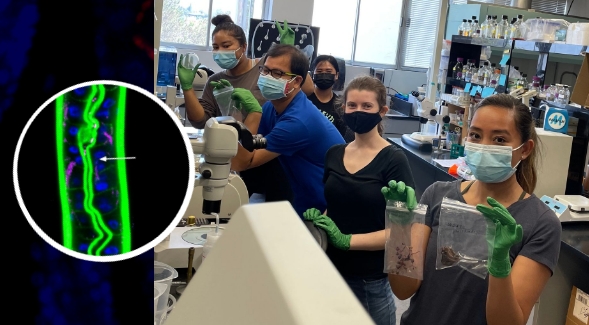My, How Youve Grown: New Species of Bacteria is a Shapeshifter Extraordinaire
SDSU biologists have identified filament form that invades multiple cells

For decades, Hollywood has been gripping moviegoers with stories about viruses and bacteria spreading through the air and bitey zombies. But now San Diego State University researchers may be breathing life into these Tinseltown tropes with their discovery of a new shapeshifting bacteria, the Bordetella atropi.
The SDSU team of biologists discovered that the B. atropi invades multiple cells within a living organism. The researchers named it after the Greek Fate Atropos who was known for cutting the threads of life.
The study, published this week in Nature Communications, describes how this new species of bacteria invades its roundworm host. The bacteria changes its shape into a long thread, growing up to 100 times the usual size of one bacterium within 30 hours without dividing.
By altering the genes of B. atropi, the research team identified that this invasive threading relies on the same genes and molecules that other bacteria use when they are in a nutrient-rich environment. However, these other bacteria only use this pathway to make subtly larger cells, whereas the B. atropi bacteria grows continuously.
Other bacteria often transform into threads, called filamentation, in response to dangerous environments or damage to their DNA. This lets them continue to grow in size, but delay dividing into new bacterial cells until they fix the damage caused by the stress.
Here, however, the researchers were the first to observe filamentation as a way of spreading from cell to cell in a living organism for a purpose other than the stress response. They believe that instead the new species is invading the host cells, detecting this rich environment and triggering filamentation to quickly infect more cells and access additional nutrients for their growth.
“We went from finding the worm in the ground, finding the bacteria, and carrying it all the way to the molecular mechanism of how the bacteria infects the worm,” Robert Luallen, biology professor and principal investigator of the study, said. “We’re seeing things that no one’s ever seen before.”
Although neither the bacteria nor the roundworm that Luallen studies will infect humans, it is possible that the spreading mechanism may also be used by human pathogens. Separately, the nutrient-induced filamentation process might be used by other bacteria to form biofilms, which can coat the tubing of catheters and lead to complications for patients.
In the photo: Emily Morgan (top left), Tuan Tran, Dalaena Rivera, Kayla Poirier, Candyd Lace Velasquez pose at Luallen Lab at SDSU. Inset: Microscope image of Bordetella atropi (pink lines) infecting roundworm intestine (green).



